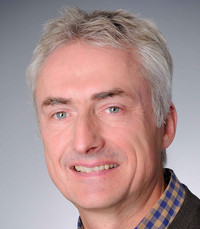The main research focus of our lab is the molecular control of cell polarity. One major research topic is the control of epithelial apical-basal and planar cell polarity. Both types of polarity are essential for proper morphogenesis. The second major research topic is the polarity and asymmetric division of stem cells. Asymmetric cell division (ACD) is a key mechanism to ensure tissue homeostasis and prevent the formation of tumors. As model organism for our research we use the fruit fly Drosophila melanogaster.
Cell polarity is a fundamental feature of many cell types. In epithelia, apical-basal polarity is the prerequisite for the formation of functionally distinct plasma membrane domains that differ in their protein and lipid composition. Proper apical-basal polarity is important for the correct assembly of intercellular junctions, which are essential for epithelial tissue integrity. Loss of apical-basal polarity is one of the major hallmarks in the transition from benign to invasive epithelial cancers. A second type of epithelial polarity within the plane of the epithelium, so-called planar cell polarity (PCP), is essential for morphogenetic movements of epithelial cells, for instance during germ band extension in the fly embryo or for convergent extension movements during vertebrate gastrulation. In stem cells, cell polarity is required for the asymmetric localization of cell fate determinants and for proper spindle orientation, which leads to the formation of two unequal daughter cells upon ACD. In most cases, one of the two daughter cells formed upon ACD will again be a stem cell, while the second daughter cell undergoes terminal differentiation, either directly or after formation of an intermediate precursor cell. Defects in the control of cell polarity and ACD of stem cells can cause premature differentiation and loss of the stem cells or over-proliferation of stem cells resulting in tumor formation.
Genetic screens in the fruit fly have led to the discovery of mutations in genes that result in the loss of cell polarity in epithelia. Research on homologs of these genes in worms and vertebrates revealed that most of them are evolutionarily conserved and have a universal function in the molecular control of cell polarity in many different cell types. Among the best-studied of these genes are the so-called partitioning defective (PAR) genes. We and others could show that the PAR proteins Bazooka/PAR-3, PAR-6 and atypical protein kinase C (aPKC) form a protein complex localized in the apical cortex of epithelial cells that controls the correct formation and positioning of adherens junctions (AJs) and plasma membrane polarity. More recently, we have isolated protein interaction partners of Bazooka/PAR-3 that are involved in the control of PCP and the regulation of actomyosin contractility at AJs. By a combined approach using genetics, biochemistry and imaging we aim to unravel the function of molecular networks that control cell polarity and morphogenesis in the fruit fly with implications for vertebrate epithelial biology and diseases affecting epithelia, including cancer.
Work by us and others has shown that polarity and ACD of different types of stem cells in the fruit fly is controlled by similar molecular mechanisms as in epithelia. Most notably, the PAR-complex is required for cortical polarity in neuroblasts, the stem cells of the central nervous system. More recently, we have started to analyze the regulatory transcriptional networks functioning upstream of the polarity regulators. We found that the so-called Tip60 chromatin remodelling complex is essential for stem cell maintenance in the nervous system. Loss-of-function of several members of the Tip60 complex results in premature differentiation and loss of the stem cells. Interestingly, neuroblasts mutant for Tip60 complex members also display a loss of cell polarity, caused by downregulation of the PAR complex member aPKC. As the Tip60 complex has been implicated in stemness maintenance of vertebrate embryonic stem cells, our work has demonstrated a universal function of this complex in stem cells. We are currently analyzing the function of this complex in additional types of stem cells in the fruit fly. In the larval gut, loss-of-function of Tip60 complex members also leads to stem cell loss and premature differentiation. We have started to identify target genes regulated by the Tip60 complex using targeted DamID, combined with transcriptome analysis by RNA-seq. From the results of this work we expect important insights into the genetic networks functioning at the top of the hierarchy that decides whether a cell will be maintained as a stem cell or will enter a differentiation program.
In an independent stem cell project, we study the interplay between methuselah GPCR signaling and female germ line stem cells in longevity. In various species, animals lacking germ cells live longer than animals with a normal germ line. On the other hand, mutation of the methuselah gene encoding a GPCR leads to a significant increase in life span. Whether these two phenomena are interconnected is the question behind this project.
The establishment and maintenance of proper cell polarity is essential for tissue integrity and physiological function of epithelia and for ACD of stem cells. Both in epithelia and stem cells, loss of cell polarity is a crucial step in the development and progression of tumors. Understanding the molecular control of cell polarity may therefore open up new therapeutic opportunities for fighting cancer.

Institute I of Anatomy| RG Molecular Cell Biology
CMMC - PI - assoc. RG 24
show more…0221 478 82880
+49 221 478 32400
Institute I of Anatomy| RG Molecular Cell Biology
Kerpener Str. 62
50937 Cologne
Irina Peek (PostDoc)
Klaus Nohroudi (PostDoc)
Soya Kim (Postdoc)
Hong Nguyen (PhD student)
Patrizia Kroll (PhD student)
Bharath Giriyapura (PhD student)
Ferdi Grawe (technician)
Monique Ulepic (technician)
Jolanta Kozlowski (technician)
Christian Hoffmann (technician)